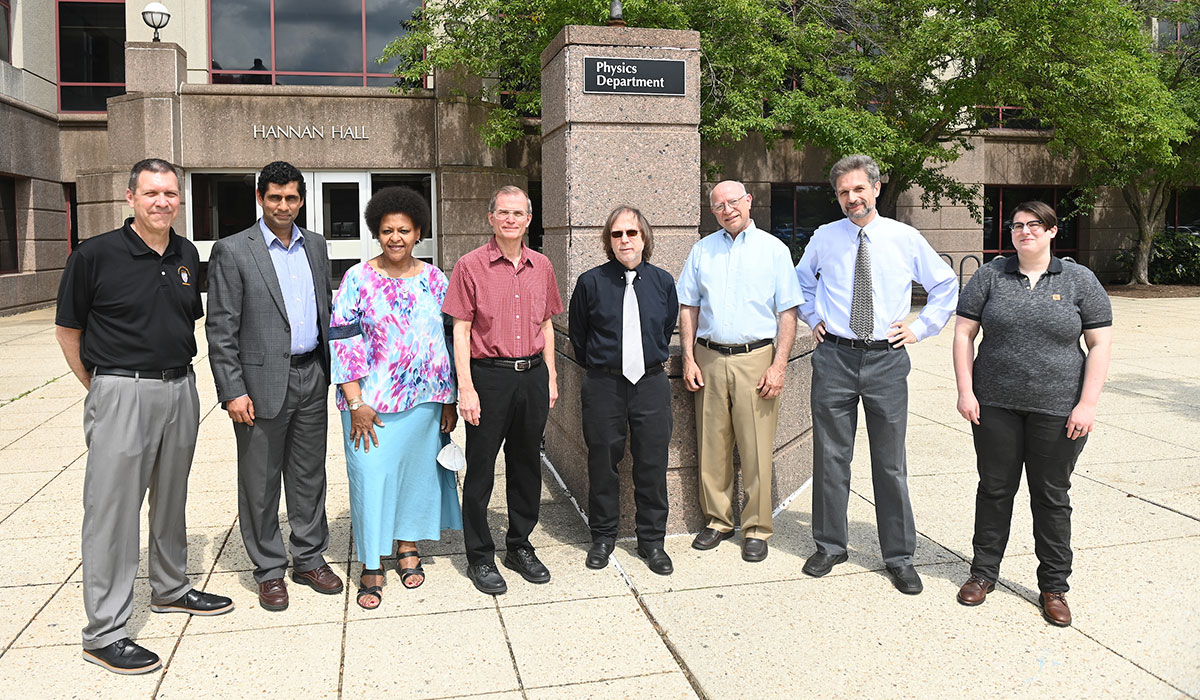

L-R: Ralph Albano, John Philip (Physics Chair), Gina Vandross-Martin (PHaSER senior budget analyst), Jeff Brosius (PHaSER deputy PI), Steve Kraemer, Professor of Physics; Bob Robinson (PHaSER PI), Vadim Uritsky (Associate Professor, Physics), Lizz Bowlen (IACS budget analyst)
It was recently announced that The Catholic University of America has received a $64.1 million research award from NASA to fund a cooperative agreement with CatholicU’s Institute for Astrophysics and Computational Sciences and five other local partners: University of Maryland Baltimore County (UMBC), University of Maryland College Park (UMCP), George Mason University (GMU), Howard University (HU), and Universities Space Research Association (USRA).
The agreement establishes the Partnership for Heliophysics and Space Environment Research (PHaSER) with funding for the next five years. PHaSER will support the scientific and technical program of NASA Goddard Space Flight Center’s Heliophysics Science Division (HSD).
“When executed, this becomes the largest single research grant in the history of The Catholic University of America, and when taken with our recent subaward on the CRESST II NASA cooperative agreement, pushes our NASA-funded project total to just over $90 million over the next five years,” says University Provost Aaron Dominguez.
The guiding principles of PHaSER are to:
“The overall purpose is to enable scientific research in the Heliophysics Division at NASA Goddard,” said Bob Robinson, director of PHaSER and research professor of physics at CatholicU. “The mission of the Heliophysics Division is to study the transport of energy, in the form of particles and radiation from the sun through interplanetary space and its effects on Earth’s atmosphere and ionosphere.”
PHaSER will primarily support HSD through the recruitment, hiring, and retention of high-quality scientists and students in cooperation with the HSD scientists responsible for specific research areas.
“PHaSER represents a network as much as a partnership, and we will leverage the many linkages the member institutions have to help move HSD scientific and technical projects forward,” the group said in its proposal. “This is particularly important for being well positioned to support new initiatives in HSD by providing access to people and resources with little delay and optimum results.”
Similarly, PHaSER will support special programs to stimulate and support HSD collaborations, connections, and scientific interchanges with the external science communities through visiting scientist, postdoc and sabbatical support, student and internship programs, and conference hosting and organization.
Cooperative agreements like PHaSER “help fulfill the University’s mission in education, providing opportunities for CatholicU students and faculty to take advantage of the expertise and resources that we have at NASA Goddard,” says Robinson. “I’m excited to see that connection continue and strengthen under the new agreement.”
PHaSER continues and expands the on-going support currently undertaken through two separate cooperative agreements: the Center for Excellence in the Physics of the Heliosphere and Sun (CEPHEUS), led by CatholicU with subawards to GMU; and the Goddard Planetary Heliophysics Institute (GPHI) led by UMBC in partnership with UMCP.
Through CEPHEUS, researchers have been studying space weather — solar phenomena like flares, storms, and coronal mass ejections — that can adversely affect radio communications, satellite technologies, and power grids on Earth. As a part of this research, the Catholic University Physics Department opened a Space Weather Center on campus in 2016. In this center, students -- both undergraduate and graduate -- have access to solar monitoring feeds and equipment modeled after those found at NASA Goddard.
Through CEPHEUS, CatholicU has been employing 50 to 70 full- and part-time scientists associated with HSD. Together with its PHaSER partners, the number of affiliated scientists will grow to 80 to 100 researchers under the new award.
PARTNERS:
MEDIA: For more information or to interview Bob Robinson, contact the Office of Communications at communications@cua.edu.